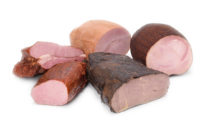Gums, binders andother emulsifiers have been investigated for years for their ability to bind pieces of meat, hold moisture, extend product and stabilize product for whatever particular performance interest desired. For example, gums, binders and other emulsifiers can improve sliceability or texture of a product along with other rheological properties, such as how the product performs after numerous reheating or freeze-thaw cycles, says Jeff Sindelar, extension meat specialist at the University of Wisconsin-Madison.
While many of these ingredients have been around for a while, today sodium alginate is emerging because of its functionality, Sindelar says. Sodium alginate has the ability to provide extension and binding capabilities in addition to being perceived as a little bit friendlier item on an ingredient statement, he explains.
Advancement also continues in the use of gums, binders and emulsifiers. For example, fibers now are functioning as phosphate replacers, and fibers, cellulose, carrageenan and guar gum are working as fat replacers, says Wes Schilling, professor of food science at Mississippi State University in Starkville.
Many developments in this area revolve around process or packaging changes, says Edward Mills, associate professor of meat science at Penn State University College of Agricultural Sciences, in University Park, Pa. “Ingredients like soy protein, starches, carrageenan, konjac or gelatin may be used in an effort to increase firmness, reduce fluid purge or improve product appearance,” he says. “Formulation cost is always a constraining factor, so use of hydrocolloid gums may not be considered as a viable option.”
A combination of binding, extension and offsetting the cost of high meat prices also has driven research of gums, binders and emulsifiers, Sindelar says. “We’re adding possibly water to address the least cost formulation,” he explains. “You can use the meat block itself and lower-cost types of meats to create products that have organoleptic properties of a more expensive product.”
Clean-label, natural and organic products are other areas that have driven research of some gums, binders and emulsifiers. The task is trying to identify those that are more native, such as modified food starch versus potato starch, and how those perform and how the functionality of those is measured compared with either the non-native or the less pure version, Sindelar says.
Processors often experiment with several ingredients in order to get the right combination of functional improvement, cost control and minimal label impact, Mills says. For example, an ingredient such as potato starch might be more label friendly than carrageenan, he says.
“There are many ingredient choices available for processors, so they can usually find something that solves the problem at hand,” he explains. “However, it may take numerous trials to find the right ingredient. As for consumer expectations, it is likely that anything on the product label that is not meat or seasoning may be perceived as undesirable.”
Processors are always looking for new ingredients to help achieve a cleaner label and ingredients that are healthy, Schilling says. Examples of such ingredients include rice bran, microcrystalline cellulose, inulin, pea fiber, soy fiber, citrus fiber, plum fiber, corn fiber and oat fiber, he says.
Using mixes of gums and other ingredients is another area of development Schilling sees. For example, carrageenan will commonly be included with modified food starch and phosphate in a blend and then included in products to bind water and improve protein functionality, he says. Xanthan gum also is used in mixes with carrageenan as a dispersing agent for carrageenan. In addition, guar gum is being mixed in with carrageenan to decrease the price of the mix, Schilling says.





Report Abusive Comment